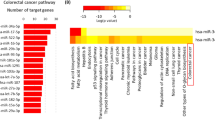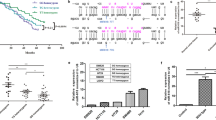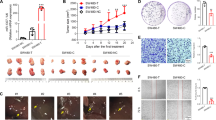Abstract
MiR-124 functions as a tumor suppressor and plays an important role in tumorigenesis. A common polymorphism (rs531564, C>G) in the pri-miR-124 has been recently studied in connection with cancer risk. The aim of the present study was to investigate the association between pri-miR-124 rs531564 polymorphism and the risk and clinicopathological characteristics of colorectal cancer (CRC). Two case-control studies involving 900 CRC patients and 1110 cancer-free controls showed that pri-miR-124 rs531564 polymorphism was significantly associated with the decreased risk of CRC in Xuzhou population [GG vs. CC: OR = 0.25, 95%CI = 0.09–0.67, P = 0.003; (CG+GG) vs. CC: OR = 0.73, 95%CI = 0.56–0.94, P = 0.01; GG vs. (CC+CG): OR = 0.27, 95%CI = 0.10–0.70, P = 0.004; G vs. C: OR = 0.70, 95%CI = 0.56–0.89, P = 0.003], Bengbu population [GG vs. CC: OR = 0.20, 95%CI = 0.04–0.90, P = 0.02; GG vs. (CC+CG): OR = 0.21, 95%CI = 0.05–0.95, P = 0.03; G vs. C: OR = 0.72, 95%CI = 0.54–0.98, P = 0.03] and pooled population [GG vs. CC: OR = 0.26, 95%CI = 0.11–0.59, P<0.001; (CG+GG) vs. CC: OR = 0.76, 95%CI = 0.62–0.93, P = 0.008; GG vs. (CC+CG): OR = 0.27, 95%CI = 0.12–0.62, P < 0.001; G vs. C: OR = 0.71, 95%CI = 0.59–0.85, P<0.001]. Additionally, pri-miR-124 rs531564 polymorphism was significantly associated with the decreased risk of poor differentiation and lymph node metastasis of CRC. Our results suggest that pri-miR-124 rs531564 polymorphism may be a genetic modifier for developing CRC. However, further studies are needed to validate our findings.
Similar content being viewed by others
Introduction
Colorectal cancer (CRC) is a major public health problem and a leading cause for human deaths in the world1. Although the pathogenesis of CRC remains largely unknown, a number of studies have demonstrated that CRC is a complex disease that results from environmental and genetic factors. Host genetic factors may play an important role in individual susceptibility to CRC2,3.
MicroRNAs (miRNAs) are a class of endogenous, small, noncoding RNAs that modulate the activity of specific mRNA targets and play vital roles in a wide range of physiologic and pathologic processes. Increasing evidence showed that deregulation of miRNAs expression was involved in tumor initiation and progression. MiR-124 was initially confirmed to be a brain-enriched miRNA which was necessary for embryonic neuronal differentiation4,5. Recently, miR-124 has been found to be a potential tumor suppressor, which is epigenetically silenced in various types of cancer and regulates the biological behaviors of cancer cell by targeting several important genes, including rho-kinase 2 (ROCK2), enhancer of the zeste homologue 2 (EZH2), sphingosine kinase 1 (SPHK1) and the androgen receptor6,7,8,9.
Single nucleotide polymorphisms (SNPs) are a type of common genetic variation associated with disease susceptibility10. The functional polymorphisms in the miRNA gene may affect the expression or function of miRNA and have attracted increasing attention. A common polymorphism (rs531564, C > G) in the pri-miR-124 has been identified and shown to influence the expression of mature miR-12411. In addition, pri-miR-124 rs531564 polymorphism was reported to be significantly correlated with the risk of various cancers, including cervical cancer and esophageal squamous cell carcinoma (ESCC)12,13,14. Thus, we hypothesized that the potentially functional polymorphism also contributed to the risk of CRC.
In the current study, we firstly conducted two independent case-control studies in Chinese population to investigate the associations and then examined the clinicopathological characteristics of CRC for different genotypes.
Results
Pri-miR-124 rs531564 polymorphism and CRC risk
The selected characteristics of enrolled subjects are listed in Table 1. No significant difference was found in distributions of age and gender. Association of the pri-miR-124 rs531564 polymorphism with CRC risk was shown in Table 2. In Xuzhou population, the pri-miR-124 rs531564 polymorphism was significantly associated with the decreased risk of CRC [GG vs. CC: OR = 0.25, 95%CI = 0.09–0.67, P = 0.003; (CG+GG) vs. CC: OR = 0.73, 95%CI = 0.56–0.94, P = 0.01; GG vs. (CC+CG): OR = 0.27, 95%CI = 0.10–0.70, P = 0.004; G vs. C: OR = 0.70, 95%CI = 0.56–0.89, P = 0.003]. Similar results were also observed in Bengbu population [GG vs. CC: OR = 0.20, 95%CI = 0.04–0.90, P = 0.02; GG vs. (CC+CG): OR = 0.21, 95%CI = 0.05–0.95, P = 0.03; G vs. C: OR = 0.72, 95%CI = 0.54–0.98, P = 0.03] and pooled population [GG vs. CC: OR = 0.26, 95%CI = 0.11–0.59, P < 0.001; (CG + GG) vs. CC: OR = 0.76, 95%CI = 0.62–0.93, P = 0.008; GG vs. (CC + CG): OR = 0.27, 95%CI = 0.12–0.62, P < 0.001; G vs. C: OR = 0.71, 95%CI = 0.59–0.85, P < 0.001].
Clinicopathological characteristics of CRC for different genotypes
The association between pri-miR-124 rs531564 polymorphism and clinicopathological characteristic of CRC patients was conducted in two independent studies (Table 3). Significant associations were found in status of differentiation and lymph node metastasis. In CRC patients from Xuzhou city, the pri-miR-124 rs531564 polymorphism was associated with the decreased risk of poor differentiation [(CG+GG) vs. CC: OR = 0.67, 95%CI = 0.45–0.99, P = 0.05; G vs. C: OR = 0.69, 95%CI = 0.48–0.99, P = 0.04] and lymph node metastasis [CG vs. CC: OR = 0.65, 95%CI = 0.43–0.96, P = 0.03; (CG+GG) vs. CC: OR = 0.64, 95%CI = 0.43–0.95, P = 0.03; G vs. C: OR = 0.67, 95%CI = 0.47–0.96, P = 0.03]. In CRC patients from Bengbu city, the pri-miR-124 rs531564 polymorphism was also associated with the decreased risk of poor differentiation [(CG + GG) vs. CC: OR = 0.56, 95%CI = 0.33–0.98, P = 0.04; G vs. C: OR = 0.58, 95%CI = 0.34–0.96, P = 0.03] and lymph node metastasis [(CG+GG) vs. CC: OR = 0.58, 95%CI = 0.34–0.97, P = 0.04; G vs. C: OR = 0.59, 95%CI = 0.37–0.96, P = 0.03]. Furthermore, these associations of pri-miR-124 rs531564 polymorphism with the decreased risk of poor differentiation [(CG+GG) vs. CC: OR = 0.66, 95%CI = 0.48–0.90, P = 0.01; G vs. C: OR = 0.65, 95%CI = 0.48–0.87, P = 0.003] and lymph node metastasis [CG vs. CC: OR = 0.71, 95%CI = 0.51–0.98, P = 0.04; (CG + GG) vs. CC: OR = 0.64, 95%CI = 0.47–0.88, P = 0.006; G vs. C: OR = 0.62, 95%CI = 0.46–0.82, P < 0.001] were also observed in pooled patients.
Discussion
Similar to the protein-coding genes, miRNAs are transcribed for the majority by RNA polymerase II as long primary miRNA (pri-miRNAs) transcripts with stem-loop structure15. The pri-miRNAs are processed to produce miRNA precursors (pre-miRNAs) and then further cleaved into mature miRNAs which act mainly through annealing to 3′ untranslated regions (3′UTRs) of gene transcripts, leading to inhibition of further steps of gene expression. MiR-124 is a highly conserved miRNA and plays an important role in neural processes, from nervous system development to normal neuronal cell function16. Nowadays, miR-124 has been reported to be a potential tumor suppressor and an independent prognostic marker in many cancers, including colorectal cancer, prostate cancer and nasopharyngeal carcinoma17,18,19. The miR-124 gene is located in 8p23 and has an identified polymorphism (rs531564) which affects miR-124 expression11. The associations of rs531564 polymorphism and cancer risk have been reported; however, the results of previous studies are controversial. Most studies showed that rs531564 polymorphism was associated with decreased risk of cancer, such as cervical cancer and esophageal squamous cell carcinoma; however, one study indicated no association between rs531564 polymorphism and cancer risk including esophageal cancer, which was probably due to difference in genotyping method, cancer type or source of controls12,13,14,20.
In two independent case-control studies from Xuzhou population (577 CRC patients and 690 healthy controls) and Bengbu population (323 CRC cases and 420 healthy subjects), we found that pri-miR-124 rs531564 polymorphism was significantly associated with the decreased risk of CRC, which is similar to the results of the recent meta-analysis21. Analysis based on bioinformatics and gene expression showed that the G allele in the rs531564 polymorphism changed the formation of a ring-shaped structure in miR-124, which was beneficial to the increase of the amount of mature miR-12411. Therefore, we speculated that the role of pri-miR-124 rs531564 polymorphism in CRC susceptibility was associated with the stability of the pri-miRNA, or the efficiency of processing of pri-miRNA into mature miRNA. Furthermore, our results showed that pri-miR-124 rs531564 polymorphism was significantly associated with clinicopathological characteristics of CRC patients, including poor differentiation and lymph node metastasis. To the best of our knowledge, this is the first molecular epidemiological study to investigate the associations of pri-miR-124 rs531564 polymorphism with the risk and clinicopathological characteristics of CRC. However, we could not determine the interaction between pri-miR-124 rs531564 polymorphism and potential risk factors, such as drinking, red meat consumption and body mass index, because of a lack of enough individual data in case-control studies.
Taken together, our findings suggest that pri-miR-124 rs531564 polymorphism contributes to the decreased risk of CRC, poor differentiation and lymph node metastasis in Chinese population, possibly by affecting miR-124 expression. However, further research in this field is warranted to complete understanding of carcinogenesis associated with the pri-miR-124 rs531564 polymorphism.
Materials and Methods
Study population
Two independent case-control studies were conducted in unrelated ethnic Han Chinese. Briefly, 577 CRC patients and 690 age and gender frequency-matched healthy controls were recruited from the Affiliated Hospital of Xuzhou Medical College between July 2013 and December 2014 and 323 CRC cases and 420 cancer-free controls were enrolled from December 2013 to January 2015 in the Affiliated Hospital of Bengbu Medical College. Patients were confirmed by routine histopathological examination and received no chemotherapy or radiation therapy before surgery. Control subjects were without any previous cancer diagnosis and selected from a pool of controls by normal physical examination. Demographic and clinicopathological data were collected from medical records and histopathology reports. Written informed consent was obtained from all patients and healthy control subjects before study entry. The study design and protocol were approved by the ethics committee of The Affiliated Hospital of Bengbu Medical College and Xuzhou Medical College, China. Methods were carried out in accordance with the approved guidelines.
DNA extraction and genotyping
The genomic DNA of each subject was isolated from peripheral blood samples using genomic DNA extraction kit (Qiagen) according to the manufacturer’s protocol. DNA fragments containing rs531564 were amplified with the following primers (forward: 5-TCTTCTACCCACCCCTCTTCC-3; reverse: 5-AATCTGCACACACAAGCACTC-3). The PCR products were sequenced in forward direction. The SNP genotypes were determined by DNAMAN and BLAST.
Statistical Analysis
Differences in general characteristics were examined using Student’s t-test or χ2 test. The Hardy-Weinberg equilibrium (HWE) was tested by a goodness-of-fit χ2 test to compare the expected genotype frequencies with observed genotype frequencies in cancer-free controls. Logistic regression was used to analyze the association between the rs531564 polymorphism and the risk and clinicopathological characteristics of CRC, adjusted by confounding factors including age, gender, family history of cancer, tumor site, differentiation, TNM and/or lymph node metastasis when appropriate. In Table 3, all the comparisons are done using the second characteristic as reference. P < 0.05 was used as the criterion of statistical significance. All statistical analyses were implemented in the SPSS statistical software (version 19.0).
Additional Information
How to cite this article: Gao, X.- et al. Pri-miR-124 rs531564 polymorphism and colorectal cancer risk. Sci. Rep. 5, 14818; doi: 10.1038/srep14818 (2015).
References
Jemal, A. et al. Global cancer statistics. CA Cancer J Clin 61, 69–90 (2011).
Gao, X., Zhang, S. & Zhu, Z. Genetic variation of ErbB4 confers risk of colorectal cancer in a Chinese Han population. Cancer Biomark 14, 435–439 (2014).
Gao, X., Zhang, S. & Zhu, Z. Lysyl oxidase rs1800449 polymorphism and cancer risk among Asians: evidence from a meta-analysis and a case-control study of colorectal cancer. Mol Genet Genomics 290, 23–28 (2015).
Lagos-Quintana, M. et al. Identification of tissue-specific microRNAs from mouse. Curr Biol 12, 735–739 (2002).
Cao, X., Pfaff, S. L. & Gage, F. H. A functional study of miR-124 in the developing neural tube. Genes Dev 21, 531–536 (2007).
Wang, P. et al. Methylation-mediated silencing of the miR-124 genes facilitates pancreatic cancer progression and metastasis by targeting Rac1. Oncogene 33, 514–524 (2014).
Zheng, F. et al. The putative tumour suppressor microRNA-124 modulates hepatocellular carcinoma cell aggressiveness by repressing ROCK2 and EZH2. Gut 61, 278–289 (2012).
Xia, J. et al. miR-124 inhibits cell proliferation in gastric cancer through down-regulation of SPHK1. J Pathol 227, 470–480 (2012).
Shi, X. B. et al. Tumor suppressive miR-124 targets androgen receptor and inhibits proliferation of prostate cancer cells. Oncogene 32, 4130–4138 (2013).
Cong, J., Zhang, S. & Gao, X. Quantitative assessment of the associations between CD28 T > C polymorphism (rs3116496) and cancer risk. Tumour Biol 35, 9195–9200 (2014).
Qi, L. et al. A SNP site in pri-miR-124 changes mature miR-124 expression but no contribution to Alzheimer’s disease in a Mongolian population. Neurosci Lett 515, 1–6 (2012).
Wu, H. & Zhang, J. miR-124 rs531564 polymorphism influences genetic susceptibility to cervical cancer. Int J Clin Exp Med 7, 5847–5851 (2014).
Xiong, X. et al. Correlation analysis between miR-124 rs531564 polymorphisms and susceptibility to cervical cancer. Nan Fang Yi Ke Da Xue Xue Bao 34, 210–213 (2014).
Zhang, J. et al. Pri-miR-124 rs531564 and pri-miR-34b/c rs4938723 polymorphisms are associated with decreased risk of esophageal squamous cell carcinoma in Chinese populations. PLoS One 9, e100055 (2014).
Mo, Y. Y. MicroRNA regulatory networks and human disease. Cell Mol Life Sci 69, 3529–3531 (2012).
Clark, A. M. et al. The microRNA miR-124 controls gene expression in the sensory nervous system of Caenorhabditis elegans. Nucleic Acids Res 38, 3780–3793 (2010).
Wang, M. J. et al. Downregulation of microRNA-124 is an independent prognostic factor in patients with colorectal cancer. Int J Colorectal Dis 28, 183–189 (2013).
Shi, X. B. et al. Tumor suppressive miR-124 targets androgen receptor and inhibits proliferation of prostate cancer cells. Oncogene 32, 4130–4138 (2013).
Peng, X. H. et al. MiR-124 suppresses tumor growth and metastasis by targeting Foxq1 in nasopharyngeal carcinoma. Mol Cancer 13, 186 (2014).
Yin, J. et al. Hsa-miR-34b/c rs4938723 T>C and hsa-miR-423 rs6505162 C>A polymorphisms are associated with the risk of esophageal cancer in a Chinese population. PLoS One 8, e80570 (2013).
Fang, C. et al. Association of the pri-miR-124-1 rs531564 polymorphism with cancer risk: A meta-analysis. Mol Clin Oncol 3, 892–896 (2015).
Author information
Authors and Affiliations
Contributions
Conceived and designed the experiments: G.X., W.H. and Z.S. Performed the experiments: G.X., W.H. and Z.S. Analyzed the data: G.X. and Z.S. Contributed reagents/material/analysis tools: G.X., Z.S., W.M. and Z.Z. Wrote the main manuscript text: G.X. and Z.Z. Reference collection and data management: G.X., W.H., Z.S. and Z.Z. Statistical analyses and paper writing: G.X., Z.S. and Z.Z. Study design: G.X., W.H., Z.S. and Z.Z. All authors reviewed the manuscript.
Ethics declarations
Competing interests
The authors declare no competing financial interests.
Rights and permissions
This work is licensed under a Creative Commons Attribution 4.0 International License. The images or other third party material in this article are included in the article’s Creative Commons license, unless indicated otherwise in the credit line; if the material is not included under the Creative Commons license, users will need to obtain permission from the license holder to reproduce the material. To view a copy of this license, visit http://creativecommons.org/licenses/by/4.0/
About this article
Cite this article
Gao, Xr., Wang, Hp., Zhang, Sl. et al. Pri-miR-124 rs531564 polymorphism and colorectal cancer risk. Sci Rep 5, 14818 (2015). https://doi.org/10.1038/srep14818
Received:
Accepted:
Published:
DOI: https://doi.org/10.1038/srep14818
This article is cited by
-
Correlation between pri-miR-124 (rs531564) polymorphism and congenital heart disease susceptibility in Chinese population at two different altitudes: a case-control and in silico study
Environmental Science and Pollution Research (2019)
-
Lentivirus-mediated microRNA-124 gene-modified bone marrow mesenchymal stem cell transplantation promotes the repair of spinal cord injury in rats
Experimental & Molecular Medicine (2017)
-
Polymorphisms in MIR122, MIR196A2, and MIR124A Genes are Associated with Clinical Phenotypes in Inflammatory Bowel Diseases
Molecular Diagnosis & Therapy (2017)
Comments
By submitting a comment you agree to abide by our Terms and Community Guidelines. If you find something abusive or that does not comply with our terms or guidelines please flag it as inappropriate.



